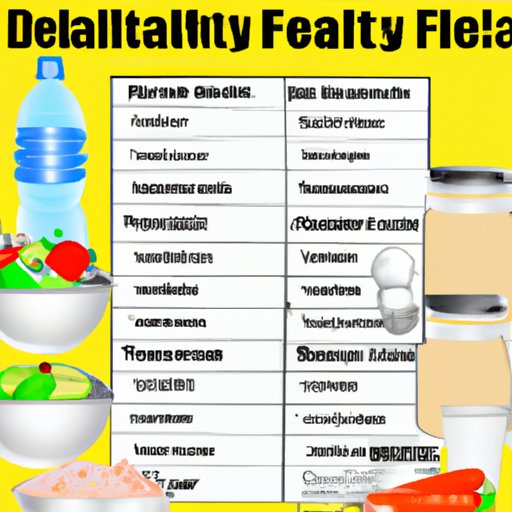Introduction
Eating a healthy diet is one of the most important steps you can take to improve your overall health and well-being. Eating a balanced diet that includes nutrient-rich foods such as fruits, vegetables, whole grains, lean proteins, healthy fats, and low-fat dairy products can help prevent chronic diseases, promote weight loss, and increase energy levels.
Identify Nutrient-Rich Foods to Include in Your Diet
Fruits and vegetables are some of the most nutrient-dense foods you can include in your diet. They are rich sources of vitamins, minerals, antioxidants, and fiber. Eating a variety of different colored fruits and vegetables can ensure that you are getting all the essential vitamins and nutrients your body needs. Additionally, whole grains like oats, quinoa, and brown rice are excellent sources of complex carbohydrates, which provide your body with long-lasting energy. Furthermore, incorporating lean proteins such as fish, chicken, beans, lentils, and tofu can help provide your body with important amino acids. Healthy fats like avocados, nuts, and seeds are also great additions to a healthy diet, as they contain essential fatty acids and can help keep you feeling fuller for longer. Finally, low-fat dairy products like milk, yogurt, and cheese are great sources of calcium, protein, and other essential vitamins and minerals.

Create a Meal Plan with Healthy Options
Creating a meal plan with healthy options is a great way to ensure that you are eating a well-balanced diet. Incorporate nutrient-dense foods such as fruits, vegetables, whole grains, lean proteins, healthy fats, and low-fat dairy products into your meals. Aim to include a variety of colors and textures in your meals, as this can make them more visually appealing and enjoyable to eat. Additionally, it is important to consider any dietary restrictions or allergies you may have when creating your meal plan.
Learn Portion Control Techniques
Portion control is an important aspect of eating a healthy diet. Using smaller plates can help you keep track of how much food you are consuming. Additionally, measuring out servings can help you maintain accurate portion sizes. Finally, eating slowly can help you recognize when you are full and prevent overeating.
Incorporate Physical Activity into Your Routine
In addition to eating a healthy diet, incorporating physical activity into your routine can help you reach your health goals. Find an activity that you enjoy and aim for at least 30 minutes of physical activity per day. It is important to set realistic goals and start small. This can help you stay motivated and increase your chances of success.

Avoid Processed and Refined Foods
Processed and refined foods are often high in calories, sugar, and unhealthy fats and may lack essential vitamins and minerals. Reading labels on food packaging can help you identify processed foods. Whenever possible, look for whole food alternatives such as fresh fruits and vegetables.
Stay Hydrated with Water and Low-Sugar Beverages
Staying hydrated is an important part of maintaining a healthy diet. Drinking at least 8 glasses of water per day can help keep your body functioning properly. Additionally, avoiding sugary drinks such as soda and juice can help reduce your intake of added sugars.
Conclusion
Eating a healthy diet can provide numerous benefits such as preventing chronic diseases, promoting weight loss, and increasing energy levels. To achieve optimal health, focus on making nutrient-rich choices, controlling portion size, incorporating physical activity into your routine, avoiding processed and refined foods, and staying hydrated. Taking these steps can help you lead a healthier and happier life.
(Note: Is this article not meeting your expectations? Do you have knowledge or insights to share? Unlock new opportunities and expand your reach by joining our authors team. Click Registration to join us and share your expertise with our readers.)
